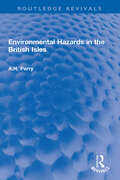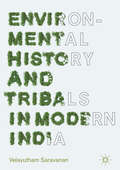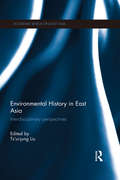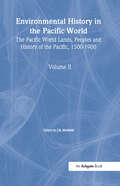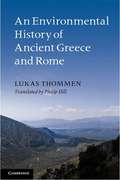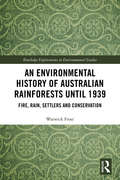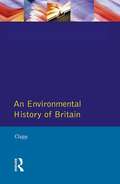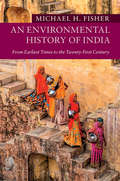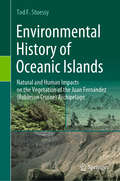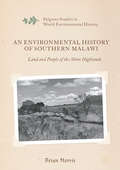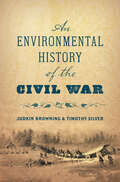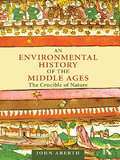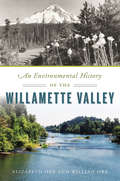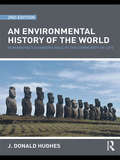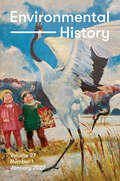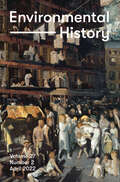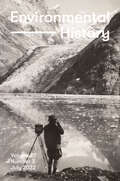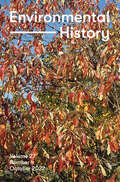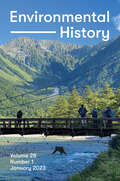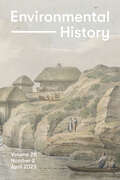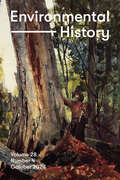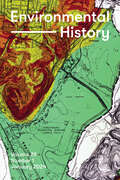- Table View
- List View
Environmental Hazards in the British Isles (Routledge Revivals)
by A.H. PerryEnvironmental Hazards in the British Isles (1981) offers a comprehensive account of the various hazards affecting Britain. Based on a wealth of empirical data, it provides a balanced perspective on phenomena that are usually presented in a sensational way by the media and then quickly forgotten. A three-fold methodology is suggested for the study of environmental hazards, which concentrates on their incidence, their causes and their frequency, and their impact on both the individual and society as a whole.
Environmental History and Tribals in Modern India
by Velayutham SaravananThis monograph presents a comprehensive account of environmental history of India and its tribals from the late eighteenth onwards, covering both the colonial and post-colonial periods. The book elaborately discusses the colonial plunder of forest resources up to the introduction of the Forest Act (1878) and focuses on how colonial policy impacted on the Indian environment, opening the floodgates of forest resources plunder, primarily for timber and to establish coffee and tea plantations. The book argues that even after the advent of conservation initiatives, commercial exploitation of forests continued unabated while stringent restrictions were imposed on the tribals, curtailing their access to the jungles. It details how post-colonial governments and populist votebank politics followed the same commercial forest policy till the 1980s without any major reform, exploiting forest resources and also encroaching upon forest lands, pushing the self-sustainable tribal economy to crumble. The book offers a comprehensive account of India’s environmental history during both colonial and post-colonial times, contributing to the current environmental policy debates in Asia.
Environmental History in East Asia: Interdisciplinary Perspectives (Academia Sinica on East Asia)
by Ts’ui-Jung LiuAs environmental history has developed as growing sub-discipline within the study of history, great emphasis has been placed on the importance of adopting an interdisciplinary approach. Indeed, as Environmental History in East Asia shows, by drawing on research and methodologies from the fields of science, technology, geography, geology and ecology, we are able to develop a much richer understanding of a region’s history. This book provides a comprehensive examination of environmental history in East Asia, ranging temporally from the Ming dynasty to the 21st Century and spatially across China, Japan and Taiwan. Split into four parts, the chapters cover a wide range of fascinating topics, comparing environmental thought and policy in the East and West, the transformation of the landscape, land resource utilization and impact of agriculture and disasters and diseases across the region. A diverse selection of case studies are used to illustrate the chapters, including the role of Daoism, Qing pasturelands and 21st century swine flu. Truly interdisciplinary in approach, this book will be of huge interest to students and scholars of Asian environmentalism, environmental history, Asian anthropology, Asian development studies and Asian history more generally.
Environmental History in the Pacific World (The Pacific World: Lands, Peoples and History of the Pacific, 1500-1900)
by J. R. McNeillThis volume brings together a set of key articles from the last 30 years pertaining to the environmental history of the Pacific basin. It aims to treat the islands and waters of the Pacific as well as the lands around the Rim, from New Zealand to Japan, to California, to Chile, and is the first work of environmental history to take this inclusive view of the Pacific basin. The focus is mainly on recent centuries but, as environmental history requires, at times the work also takes the very long view of millennia. Several of the articles seek to bring a broad Pacific perspective to bear on their subjects, while others use Pacific-basin examples to try to establish broader theoretical points of interest to all who are drawn to the study of the interactions between nature and culture. The book includes a bibliography of Pacific-basin environmental history and an introduction that aims to sketch the contours and possible future directions of the field.
An Environmental History of Ancient Greece and Rome
by Lukas Thommen Philip HillIn ancient Greece and Rome an ambiguous relationship developed between man and nature, and this decisively determined the manner in which they treated the environment. On the one hand, nature was conceived as a space characterized and inhabited by divine powers, which deserved appropriate respect. On the other, a rationalist view emerged, according to which humans were to subdue nature using their technologies and to dispose of its resources. This book systematically describes the ways in which the Greeks and Romans intervened in the environment and thus traces the history of the tension between the exploitation of resources and the protection of nature, from early Greece to the period of late antiquity. At the same time it analyses the comprehensive opening up of the Mediterranean and the northern frontier regions, both for settlement and for economic activity. The book's level and approach make it highly accessible to students and non-specialists.
An Environmental History of Australian Rainforests until 1939: Fire, Rain, Settlers and Conservation (Routledge Explorations in Environmental Studies)
by Warwick FrostThis book provides a comprehensive environmental history of how Australia’s rainforests developed, the influence of Aborigines and pioneers, farmers and loggers, and of efforts to protect rainforests, to help us better understand current issues and debates surrounding their conservation and use. While interest in rainforests and the movement for their conservation are often mistakenly portrayed as features of the last few decades, the debate over human usage of rainforests stretches well back into the nineteenth century. In the modern world, rainforests are generally considered the most attractive of the ecosystems, being seen as lush, vibrant, immense, mysterious, spiritual and romantic. Rainforests hold a special place; both providing a direct link to Gondwanaland and the dinosaurs and today being the home of endangered species and highly rich in biodiversity. They are also a critical part of Australia’s heritage. Indeed, large areas of Australian rainforests are now covered by World Heritage Listing. However, they also represent a dissonant heritage. What exactly constitutes rainforest, how it should be managed and used, and how much should be protected are all issues which remain hotly contested. Debates around rainforests are particularly dominated by the contradiction of competing views and uses – seeing rainforests either as untapped resources for agriculture and forestry versus valuing and preserving them as attractive and sublime natural wonders. Australia fits into this global story as a prime example but is also of interest for its aspects that are exceptional, including the intensity of clearing at certain periods and for its place in the early development of national parks. This book will be of great interest to students and scholars of Environmental History, Australian History and Comparative History.
Environmental History of Britain since the Industrial Revolution, An
by B. W. ClappThe present and future state of the environment gives rise to ever increasing concern, but much less is known as yet about the past: the damage that has been done since, and by, the Industrial Revolution; how far our predecessors were aware of it; the steps they took; and the gradual development of a wider concern for the state of the world and our impact on it. This timely and pioneering survey, designed for general readers as well as students and scholars, is a substantial contribution to that understanding.
An Environmental History of India: From Earliest Times to the Twenty-First Century (New Approaches to Asian History)
by Michael H. FisherIndia, Pakistan, and Bangladesh contain one-fifth of humanity, many biodiversity hotspots, and are among the nations most subject to climatic stresses. By surveying their environmental history, we can gain major insights into the causes and implications of the Indian subcontinent's current conditions. This accessible new survey begins roughly one hundred million years ago, when continental drift moved India from the South Pole and across the Indian Ocean, forming the Himalayan Mountains and creating monsoons. Coverage continues to the twenty-first century, taking readers beyond independence from colonial rule. The new nations of India, Pakistan, and Bangladesh have produced rising populations and stretched natural resources, even as they became increasingly engaged with climate change. To understand the region's current and future pressing issues, Michael H. Fisher argues that we must engage with the long and complex history of interactions among its people, land, climate, flora, and fauna.
An Environmental History of Latin America
by Shawn William MillerThis book narrates the mutually mortal historical contest between humans and nature in Latin America. Covering a period that begins with Amerindian civilizations and concludes in the region's present urban agglomerations, the work offers an original synthesis of the current scholarship on Latin America's environmental history and argues that tropical nature played a central role in shaping the region's historical development. Seeing Latin America's environmental past from the perspective of many centuries illustrates that human civilizations, ancient and modern, have been simultaneously more powerful and more vulnerable than previously thought.
An Environmental History of Medieval Europe
by Richard C. HoffmannAs the very first book of its kind, An Environmental History of Medieval Europe provides a highly original survey of medieval relations with the natural world. Engaging with the interdisciplinary enterprise of environmental history, it examines the way in which natural forces affected people, how people changed their surroundings, and how they thought about the world around them. Exploring key themes in medieval history - including the decline of Rome, religious doctrine, and the long fourteenth century - Hoffmann draws fresh conclusions about enduring questions regarding agrarian economies, tenurial rights, technology and urbanization. Revealing the significance of the natural world on events previously thought of as purely human, the book explores issues including the treatment of animals, sustainability, epidemic disease and climate change, and by introducing medieval history in the context of social ecology, brings the natural world into historiography as an agent and object of history itself.
Environmental History of Oceanic Islands: Natural and Human Impacts on the Vegetation of the Juan Fernández (Robinson Crusoe) Archipelago
by Tod F. StuessyThe Juan Fernández Archipelago is located in the Pacific Ocean west of Chile at 33° S latitude. Robinson Crusoe Island is 667 km from the continent and approximately four million years old; Alejandro Selkirk Island is an additional 181 km west and only one million years old. The natural impacts of subsidence and erosion have shaped the landscapes of these islands, resulting in progressive changes to their subtropical vegetation. The older island has undergone more substantial changes, due to both natural causes and human impacts. After the discovery of Robinson Crusoe Island in 1574, people began cutting down forests for lumber to construct boats and homes, for firewood, and to make room for pastures. Domesticated plants and animals were introduced, some of which have since become feral or invasive, causing damage to the local vegetation. The wealth of historical records on these activities provides a detailed chronicle of how human beings use their environment for survival in a new ecosystem. This book offers an excellent case study on the impacts that people can have on the resources of an oceanic island.
An Environmental History of Southern Malawi: Land and People of the Shire Highlands (Palgrave Studies in World Environmental History)
by Brian MorrisThis book is a pioneering and comprehensive study of the environmental history of Southern Malawi. With over fifty years of experience, anthropologist and social ecologist Brian Morris draws on a wide range of data – literary, ethnographic and archival – in this interdisciplinary volume. Specifically focussing on the complex and dialectical relationship between the people of Southern Malawi, both Africans and Europeans, and the Shire Highlands landscape, this study spans the nineteenth century until the end of the colonial period. It includes detailed accounts of the early history of the peoples of Northern Zambezia; the development of the plantation economy and history of the tea estates in the Thyolo and Mulanje districts; the Chilembwe rebellion of 1915; and the complex tensions between colonial interests in conserving natural resources and the concerns of the Africans of the Shire Highlands in maintaining their livelihoods.A landmark work, Morris’s study constitutes a major contribution to the environmental history of Southern Africa. It will appeal not only to scholars, but to students in anthropology, economics, history and the environmental sciences, as well as to anyone interested in learning more about the history of Malawi, and ecological issues relating to southern Africa.
An Environmental History of the Civil War (Civil War America)
by Judkin Browning Timothy SilverThis sweeping new history recognizes that the Civil War was not just a military conflict but also a moment of profound transformation in Americans' relationship to the natural world. To be sure, environmental factors such as topography and weather powerfully shaped the outcomes of battles and campaigns, and the war could not have been fought without the horses, cattle, and other animals that were essential to both armies. But here Judkin Browning and Timothy Silver weave a far richer story, combining military and environmental history to forge a comprehensive new narrative of the war's significance and impact. As they reveal, the conflict created a new disease environment by fostering the spread of microbes among vulnerable soldiers, civilians, and animals; led to large-scale modifications of the landscape across several states; sparked new thinking about the human relationship to the natural world; and demanded a reckoning with disability and death on an ecological scale. And as the guns fell silent, the change continued; Browning and Silver show how the war influenced the future of weather forecasting, veterinary medicine, the birth of the conservation movement, and the establishment of the first national parks. In considering human efforts to find military and political advantage by reshaping the natural world, Browning and Silver show not only that the environment influenced the Civil War's outcome but also that the war was a watershed event in the history of the environment itself.
An Environmental History of the Middle Ages: The Crucible of Nature
by John AberthThe Middle Ages was a critical and formative time for Western approaches to our natural surroundings. An Environmental History of the Middle Ages is a unique and unprecedented cultural survey of attitudes towards the environment during this period. Humankind’s relationship with the environment shifted gradually over time from a predominantly adversarial approach to something more overtly collaborative, until a series of ecological crises in the late Middle Ages. With the advent of shattering events such as the Great Famine and the Black Death, considered efflorescences of the climate downturn known as the Little Ice Age that is comparable to our present global warming predicament, medieval people began to think of and relate to their natural environment in new and more nuanced ways. They now were made to be acutely aware of the consequences of human impacts upon the environment, anticipating the cyclical, "new ecology" approach of the modern world. Exploring the entire medieval period from 500 to 1500, and ranging across the whole of Europe, from England and Spain to the Baltic and Eastern Europe, John Aberth focuses his study on three key areas: the natural elements of air, water, and earth; the forest; and wild and domestic animals. Through this multi-faceted lens, An Environmental History of the Middle Ages sheds fascinating new light on the medieval environmental mindset. It will be essential reading for students, scholars and all those interested in the Middle Ages
An Environmental History of the Willamette Valley (Natural History)
by Elizabeth Orr William OrrWestern Oregon's Willamette Basin, once a vast wilderness, became a thriving community almost overnight. When Oregon territory was opened for homesteading in the early 1800s, most of the intrepid pioneers settled in the valley, spurring rapid changes in the landscape. Heralded as fertile with a mild climate and an abundance of natural resources, the valley enticed farmers, miners and loggers, who were quickly followed by the construction of rail lines and roads. Dams were built to harness the once free-flowing Willamette River and provide power to the growing population. As cities rose, people like Portland architect Edward Bennett and conservationist governor Tom McCall worked to contain urban sprawl. Authors Elizabeth and William Orr bring to life the changes that sculpted Oregon's beloved Willamette Valley.
An Environmental History of the World: Humankind's Changing Role in the Community of Life (Routledge Studies In Physical Geography And Environment Ser. #Vol. 2)
by J. Donald HughesThis second edition of An Environmental History of the World continues to present a concise history, from ancient to modern times, of the interactions between human societies and the natural environment, including the other forms of life that inhabit our planet. Throughout their evolutionary history, humans have affected the natural environment, sometimes with a promise of sustainable balance, but also in a destructive manner. This book investigates the ways in which environmental changes, often the result of human actions, have caused historical trends in human societies. This process has happened in every historical period and in every part of the inhabited earth. The book is organized into ten chapters. The main chapters follow a chronological path through the history of mankind, in relationship to ecosystems around the world. The first explains what environmental history is, and argues for its importance in understanding the present state of the world's ecological problems. Chapters two through eight form the core of the historical analysis, each concentrating on a major period of human history (pre-civilized, early civilizations, classical, medieval, early modern, early and later twentieth century, and contemporary) that has been characterized by large-scale changes in the relationship between human societies and the biosphere, and each gives several case studies that illustrate significant patterns occurring at that time. The chapters covering contemporary times discuss the physical impacts of the huge growth in population and technology, and the human responses to these problems. Our moral obligations to nature and how we can achieve a sustainable balance between technology and the environment are also considered. This revised second edition takes account of new research and the course of history containing new sections on global warming, the response of New Orleans to the hurricanes Katrina and Rita, and the experience of the Dutch people in protecting their low-lying lands against the encroachments of rivers, lakes, and the North Sea. New material is also offered on the Pacific Islands, including the famous case of Easter Island. This is an original work that reaches further than other environmental histories. Rather than looking at humans and the environment as separate entities, this book places humans within the community of life. The relationship between environmental thought and actions, and their evolution, is discussed throughout. Little environmental or historical knowledge is assumed from the reader in this introduction to environmental history. We cannot reach a useful understanding of modern environmental problems without the aid of perspective provided by environmental history, with its illustrations of the ways in which past decisions helped or hindered the interaction between nature and culture. This book will be influential and timely to all interested in or researching the world in which we live.
Environmental History, volume 27 number 1 (January 2022)
by Environmental HistoryThis is volume 27 issue 1 of Environmental History. Environmental History (EH) is the world’s leading scholarly journal in environmental history and the journal of record in the field. Scholarship published in EH explores the changing relationships between humans and the environment over time. This interdisciplinary journal brings together insights from geography, anthropology, the natural sciences, and many other disciplines to inform historical scholarship.
Environmental History, volume 27 number 2 (April 2022)
by Environmental HistoryThis is volume 27 issue 2 of Environmental History. Environmental History (EH) is the world’s leading scholarly journal in environmental history and the journal of record in the field. Scholarship published in EH explores the changing relationships between humans and the environment over time. This interdisciplinary journal brings together insights from geography, anthropology, the natural sciences, and many other disciplines to inform historical scholarship.
Environmental History, volume 27 number 3 (July 2022)
by Environmental HistoryThis is volume 27 issue 3 of Environmental History. Environmental History (EH) is the world’s leading scholarly journal in environmental history and the journal of record in the field. Scholarship published in EH explores the changing relationships between humans and the environment over time. This interdisciplinary journal brings together insights from geography, anthropology, the natural sciences, and many other disciplines to inform historical scholarship.
Environmental History, volume 27 number 4 (October 2022)
by Environmental HistoryThis is volume 27 issue 4 of Environmental History. Environmental History (EH) is the world’s leading scholarly journal in environmental history and the journal of record in the field. Scholarship published in EH explores the changing relationships between humans and the environment over time. This interdisciplinary journal brings together insights from geography, anthropology, the natural sciences, and many other disciplines to inform historical scholarship.
Environmental History, volume 28 number 1 (January 2023)
by Environmental HistoryThis is volume 28 issue 1 of Environmental History. Environmental History (EH) is the world’s leading scholarly journal in environmental history and the journal of record in the field. Scholarship published in EH explores the changing relationships between humans and the environment over time. This interdisciplinary journal brings together insights from geography, anthropology, the natural sciences, and many other disciplines to inform historical scholarship.
Environmental History, volume 28 number 2 (April 2023)
by Environmental HistoryThis is volume 28 issue 2 of Environmental History. Environmental History (EH) is the world’s leading scholarly journal in environmental history and the journal of record in the field. Scholarship published in EH explores the changing relationships between humans and the environment over time. This interdisciplinary journal brings together insights from geography, anthropology, the natural sciences, and many other disciplines to inform historical scholarship.
Environmental History, volume 28 number 3 (July 2023)
by Environmental HistoryThis is volume 28 issue 3 of Environmental History. Environmental History (EH) is the world’s leading scholarly journal in environmental history and the journal of record in the field. Scholarship published in EH explores the changing relationships between humans and the environment over time. This interdisciplinary journal brings together insights from geography, anthropology, the natural sciences, and many other disciplines to inform historical scholarship.
Environmental History, volume 28 number 4 (October 2023)
by Environmental HistoryThis is volume 28 issue 4 of Environmental History. Environmental History (EH) is the world’s leading scholarly journal in environmental history and the journal of record in the field. Scholarship published in EH explores the changing relationships between humans and the environment over time. This interdisciplinary journal brings together insights from geography, anthropology, the natural sciences, and many other disciplines to inform historical scholarship.
Environmental History, volume 29 number 1 (January 2024)
by Environmental HistoryThis is volume 29 issue 1 of Environmental History. Environmental History (EH) is the world’s leading scholarly journal in environmental history and the journal of record in the field. Scholarship published in EH explores the changing relationships between humans and the environment over time. This interdisciplinary journal brings together insights from geography, anthropology, the natural sciences, and many other disciplines to inform historical scholarship.
